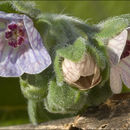en
names in breadcrumbs


Cynoglossum creticum Mill. és una espècie fanerògama pertanyent a la família de les boraginàcies. És una planta herbàcia vivaç amb tija erecte i flors amb quatre pètals clapejats de color lila. Aconsegueix els 20-80 cm d'alçada. En el primer any de creixement, apareix només una roseta amb fulles lanceolades, espesses, suaus i peludes. En el segon any apareix la inflorescència.
En altres projectes de Wikimedia: Commons (Galeria) Commons (Categoria)Die Kretische Hundszunge (Cynoglossum creticum) ist eine Pflanzenart aus der Gattung der Hundszungen (Cynoglossum) und damit der Familie der Raublattgewächse (Boraginaceae).
Die Kretische Hundszunge ist eine zweijährige krautige Pflanze und erreicht Wuchshöhen von 20 bis 80 Zentimetern. Im ersten Jahr des Wachstums wird nur eine Rosette aus lanzettlichen, dichten, weichen und behaarten Laubblättern gebildet. Im zweiten Jahr erscheint der Blütenstand. Die Laubblätter sind im oberen Teil des Stängels sitzend, halbstängelumfassend und oft ohne deutliche Seitennerven.[1]
Die Blütezeit reicht von April bis Juli.[1] Die relativ kurz gestielten Blüten erscheinen in tragblattlosen Wickeln.
Die zwittrige Blüte ist fünfzählig mit doppelter Blütenhülle. Die fünf Kelchblätter sind lanzettlich und dicht behaart. Die fünf Kronblätter sind zunächst rosafarben, später blassblau mit auffallend dunklen Nerven und röhrig verwachsen. Die Krone ist 7 bis 9 Millimeter lang, der stumpf-fünflappige, kahle Saum ist etwa so lang wie die Kronröhre. Es ist nur ein Kreis mit fünf fertilen Staubblättern vorhanden, die die Blütenkrone nicht überragen.
Die Klausenfrucht zerfällt in vier Teilfrüchte. Die nussartigen Klausen sind gewölbt, dicht mit widerhakigen Stacheln besetzt, 5 bis 7 Millimeter breit und ohne verdickten Rand.
Die Chromosomenzahl beträgt 2n = 24, seltener 48.[2]
Die Kretische Hundszunge ist ursprünglich auf den Azoren, den Kanaren und Madeira, in Nordafrika, in Südeuropa und Osteuropa, in der Schweiz, auf Inseln im Mittelmeer in Vorderasien und im Kaukasusraum weitverbreitet.[3][4] In Australien, Argentinien und Chile ist Cynoglossum creticum ein Neophyt.[4]
Sie wächst auf Brachland, an Wegrändern, in Kiefernwäldern und auf offenen grasigen Flächen.
Die Erstveröffentlichung von Cynoglossum creticum erfolgte 1768 durch Philip Miller in The Gardeners Dictionary, 8. Auflage.[5][6] Synonyme für Cynoglossum creticum Mill. sind: Cynoglossum atlanticum Murb., Cynoglossum siculum Guss., Cynoglossum pictum var. umbrosum Rouy, Cynoglossum pictum Aiton.[3]
Die Kretische Hundszunge (Cynoglossum creticum) ist eine Pflanzenart aus der Gattung der Hundszungen (Cynoglossum) und damit der Familie der Raublattgewächse (Boraginaceae).
Ameẓẓuɣ n weqjun (Isem usnan: Cynoglossum creticum) d talmest n yemɣi seg twacult n boraginaceae ![]() . Philip Miller
. Philip Miller ![]() d amdan amezwaru i yuran fell-as.
d amdan amezwaru i yuran fell-as.
Ameẓẓuɣ n weqjun (Isem usnan: Cynoglossum creticum) d talmest n yemɣi seg twacult n boraginaceae ![]() . Philip Miller
. Philip Miller ![]() d amdan amezwaru i yuran fell-as.
d amdan amezwaru i yuran fell-as.
Cynoglossum creticum is a plant in the family Boraginaceae.
It is native to the Mediterranean Basin, including the island of Crete. It is also found as an invasive plant in the states of Texas and Missouri, USA.
Cynoglossum creticum is a plant in the family Boraginaceae.
It is native to the Mediterranean Basin, including the island of Crete. It is also found as an invasive plant in the states of Texas and Missouri, USA.
Cynoglossum creticum Mill., es una especie fanerógama perteneciente a la familia de las boragináceas. Es originaria de la región mediterránea
Es una planta herbácea vivaz con tallo erecto y flores con cuatro pétalos moteados de color lila. Alcanza los 20-80 cm de altura. En el primer año de crecimiento, aparece sólo una de roseta con hojas lanceoladas, espesas, suaves y peludas. En el segundo año aparece la inflorescencia.
Cynoglossum creticum fue descrita por Philip Miller y publicado en The Gardeners Dictionary: . . . eighth edition no. 3. 1768.[1]
Cynoglossum: nombre genérico que deriva del griego cyno = "perro" y glossum = "lengua", refiriéndose a su parecido con la lengua de un perro.
creticum: epíteto geográfico que alude a su localización en Creta.
Cynoglossum creticum Mill., es una especie fanerógama perteneciente a la familia de las boragináceas. Es originaria de la región mediterránea
Cynoglossum creticum é uma espécie de planta com flor pertencente à família Boraginaceae.
A autoridade científica da espécie é Mill., tendo sido publicada em The Gardeners Dictionary: eighth edition no. 3. 1768.[1]
Os seus nomes comuns são cinoglossa-de-flor-listrada, língua-de-cão[2] ou orelha-de-lebre[3]( não confundir com as espécies Lychnis coronaria e Plantago lagopus, que consigo partilham este nome).
Trata-se de uma espécie presente no território português, nomeadamente em Portugal Continental, no Arquipélago dos Açores e no Arquipélago da Madeira.
Em termos de naturalidade é nativa de Portugal Continental e Arquipélago da Madeira e introduzida no arquipélago dos Açores.
Não se encontra protegida por legislação portuguesa ou da Comunidade Europeia.
Cynoglossum creticum é uma espécie de planta com flor pertencente à família Boraginaceae.
A autoridade científica da espécie é Mill., tendo sido publicada em The Gardeners Dictionary: eighth edition no. 3. 1768.
Os seus nomes comuns são cinoglossa-de-flor-listrada, língua-de-cão ou orelha-de-lebre( não confundir com as espécies Lychnis coronaria e Plantago lagopus, que consigo partilham este nome).
Cynoglossum creticum là loài thực vật có hoa trong họ Mồ hôi. Loài này được Mill. mô tả khoa học đầu tiên năm 1768.[1]
Cynoglossum creticum là loài thực vật có hoa trong họ Mồ hôi. Loài này được Mill. mô tả khoa học đầu tiên năm 1768.